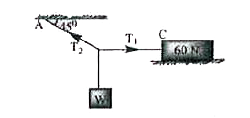A block is kept on a horizontal table. The table is undergoing simple farmonic motion of frequency 3Hz in a horizontal plane. The coefficient of static friction between the block and the table surface is 0.72. find the maximum amplitude of the table at which the block does not slip on the surface g=10ms−1
The correct Answer is:2
To solve the problem step by step, we will follow these steps:
Step 1: Identify the given values
- Frequency of the table, f=3Hz
- Coefficient of static friction, μs=0.72
- Acceleration due to gravity, g=10m/s2
Step 2: Calculate the angular frequency
The angular frequency ω can be calculated using the formula:
ω=2πf
Substituting the given frequency:
ω=2π×3=6πrad/s
Step 3: Set up the equation for maximum amplitude
The block will not slip if the maximum acceleration of the table is less than or equal to the maximum static frictional force. The maximum static frictional force can be expressed as:
Ffriction=μs⋅m⋅g
The maximum acceleration amax of the table undergoing simple harmonic motion is given by:
amax=ω2A
where A is the amplitude of the motion.
Step 4: Relate the forces
For the block to not slip:
μs⋅m⋅g≥m⋅amax
This simplifies to:
μs⋅g≥amax=ω2A
Rearranging gives:
A≤μs⋅gω2
Step 5: Substitute the values
Substituting the known values into the equation:
A≤0.72⋅10(6π)2
Calculating (6π)2:
(6π)2=36π2≈36×9.87≈355.44
Now substituting this value back:
A≤7.2355.44≈0.0203m
Step 6: Convert to centimeters
To express the amplitude in centimeters:
A≈0.0203m=2.03cm
Final Answer
The maximum amplitude of the table at which the block does not slip on the surface is approximately 2.03cm.
---
- Frequency of the table, f=3Hz
- Coefficient of static friction, μs=0.72
- Acceleration due to gravity, g=10m/s2
The angular frequency ω can be calculated using the formula:
ω=2πf
Substituting the given frequency:
ω=2π×3=6πrad/s
The block will not slip if the maximum acceleration of the table is less than or equal to the maximum static frictional force. The maximum static frictional force can be expressed as:
Ffriction=μs⋅m⋅g
The maximum acceleration amax of the table undergoing simple harmonic motion is given by:
amax=ω2A
where A is the amplitude of the motion.
For the block to not slip:
μs⋅m⋅g≥m⋅amax
This simplifies to:
μs⋅g≥amax=ω2A
Rearranging gives:
A≤μs⋅gω2
Substituting the known values into the equation:
A≤0.72⋅10(6π)2
Calculating (6π)2:
(6π)2=36π2≈36×9.87≈355.44
Now substituting this value back:
A≤7.2355.44≈0.0203m
To express the amplitude in centimeters:
A≈0.0203m=2.03cm
The maximum amplitude of the table at which the block does not slip on the surface is approximately 2.03cm.
Topper's Solved these Questions
- SIMPLE HARMONIC MOTION Book:VMC MODULES ENGLISHChapter:SIMPLE HARMONIC MOTION Exercise:6-previous year question
Explore 56 Videos
- ROTATIONAL MOTION Book:VMC MODULES ENGLISHChapter:ROTATIONAL MOTION Exercise:JEE Advanced (Archive) (True/False Type)
Explore 3 Videos
- SYSTEM OF A PARTICLES & ROTATIONAL MOTIONBook:VMC MODULES ENGLISHChapter:SYSTEM OF A PARTICLES & ROTATIONAL MOTIONExercise:IN-CHAPTER EXERCISE F
Explore 10 Videos
Similar Questions
A block is kept on a horizontal table. The stable is undergoing simple harmonic motion of frequency 3Hz in a horizontal plane. The coefficient of static friciton between block and the table surface is 0.72. find the maximum amplitude of the table at which the block does not slip on the surface.
View SolutionA heavy uniform metal chain is kept on the surface of a horizontal table. The coefficient of friction between the chain and the table surface is 0.22. Find the maximum fraction of length of the chain that could hung over on one edge of the table ?
View Solution
Knowledge Check
A 20 N block is being pushed across a horizontal table by an 18 N force. If the coefficient of kinetic friction between the block and the table is 0.4, find the acceleration of the block.
A0.5m/s2B1m/s2C5m/s2D7.5m/s2A heavy uniform chain lies on horizontal table top. If the coefficient of friction between the chain and the table surface is 0.25, then the maximum fraction of the length of the chain that can hang over one edge of the table is
A0.2B0.25C0.35D0.15
A block is kept on a rough horizontal plank. The coefficient of friction between the block and the plank is 12. The plank is undergoing SHM of angular frequency 10 rad/s. The maximum amplitude of plank in which the block does not slip over the plank is (g= 10 m/s2)
View SolutionA heavy uniform chain lies on horizontal table top. If the co-efficient of friction between the chain and the table surface is 0.5, the maximum percentage of the length of the chain that can hang over one edge of the table is
View SolutionA block on table shown in figure is just on the wedge of slipping. Find the coefficient of static friction between the block and table top.

View SolutionIn the figure, a block of weight 60N is placed on a rough surface. The coefficient of friction between the block and the surface is 0.5. The minimum weight of the block does not slip on the surface is (x×10)N. The value of x is

View SolutionA block rests on a rough inclined plane making an angle of 30∘ with the horizontal. The coefficient of static friction between the block and the plane is 0.8. If the frictional force on the block is 10N, the mass of the block (in kg) is
View SolutionA block of mass m is moving on a rough horizontal surface. μ is the coefficient of kinetic friction between the block and the surface. What is the net force exerted by the surface on the block?
View Solution

